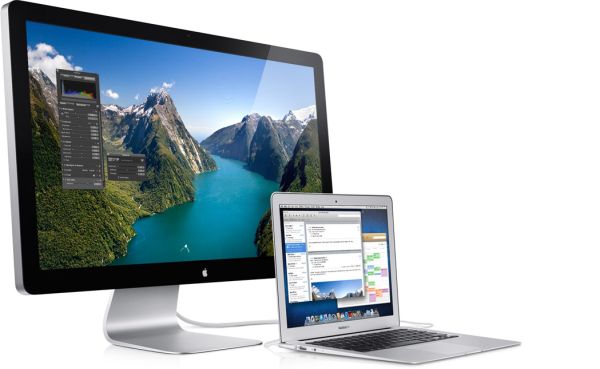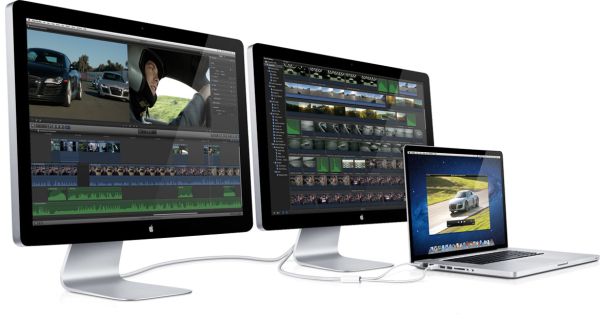Apple Updates Cinema Display, It's a Thunderbolt Display Now
by Kristian Vättö on July 20, 2011 12:25 PM EST- Posted in
- Apple
- Mac
- Cinema Display
- Thunderbolt
- Thunderbolt Display
Along with today’s MacBook Air and Mac mini updates, Apple has also updated their 27” Cinema Display. The display now goes by a new name: the Apple Thunderbolt Display (ATD). As the name implies, the display now features Intel’s new Thunderbolt interface, which Apple has heavily adopted in all new 2011 Macs. The ATD is world’s first commercially available Thunderbolt display and the second Thunderbolt device, the first one being Promise’s Pegasus enclosure.

Lets go through the specifications now:
| Apple Thunderbolt Display Specifications | |
| Screen size | 27" |
| Resolution | 2560x1440 |
| Panel type | In-plane switching (IPS) |
| Brightness | 375 cd/m2 |
| Viewing angles | 178°/178° |
| Contrast ratio | 1000:1 |
| Response time | 12ms |
| Cables (built-in) | Thunderbolt, MagSafe |
| Ports | 3x USB 2.0, FireWire 800, Gigabit Ethernet, Thunderbolt |
| Video and audio | FaceTime HD camera with mic, 2.1 speaker system |
| Dimensions (WxDxH) | 25.7" x 8.15" x 19.35" |
| Weight | 23.5lb |
| Price | $999 |
Essentially, the ATD is just a 27” Cinema Display with Thunderbolt. The screen size is the same, the resolution is the same, and I wouldn’t be surprised if the panel was exactly the same as well. From outside, you can’t see any difference, sans the extra ports. The dimensions are a match. Even the price stays at $999.
The difference comes when we talk about Thunderbolt and what it brings. The Cinema Display had three cables: Mini DisplayPort, MagSafe (power) and USB 2.0. Thanks to Thunderbolt, mDP and USB 2.0 have been merged into one and there are now only two cables: MagSafe and Thunderbolt.
Laptop-as-a-desktop users rejoice, the Thunderbolt Display features FireWire 800, USB 2.0 and Gigabit Ethernet - all of which are carried over the single Thunderbolt cable. There is also a second Thunderbolt port for daisy-chaining. As Thunderbolt provides up to 10Gb/s per channel, it’s more than adequate for 2560x1440 display and an external RAID box as we mentioned in our Promise Pegasus R6 & Mac Thunderbolt Review.
Example of daisy-chaning
Apple's Thunderbolt Display really shows us the potential of Thunderbolt by integrating many different interface standards into a single cable. Honestly the only thing that's missing is audio-out on the Thunderbolt Display itself for users who prefer external speakers.
The biggest, and possibly the only, issue here is USB 2.0 - it feels so outdated considering that nearly all PCs have USB 3.0 now. We probably won't see USB 3.0 support from Apple until Ivy Bridge brings it natively in 2012. However, even with only USB 2.0, the ATD is a great option for the owners of 2011 Macs with Thunderbolt. Apple will continue to sell the existing 27-inch Cinema Display as the new Thunderbolt Display will not work with machines that don't support Thunderbolt.
The Apple Thunderbolt Display is available from Apple's Online Store with an estimated shipping time of 6-8 weeks.











82 Comments
View All Comments
repoman27 - Thursday, July 21, 2011 - link
All your old stuff will work just fine with a new Mac. If you choose to purchase one of the two Thunderbolt accessories that has made it to market thus far, you will need a Mac with Thunderbolt in order to use it. How is this in any way a problem?This would be like arguing that even though Blu-ray players can play DVDs, they aren't backwards compatible because you can't play the Blu-ray discs in your DVD drive. Sometimes new capabilities can only be supported by new technology.
And I think you may be the first to make the statement that Apple's marketing sucks. I'm pretty sure that's one field where they really do employ geniuses.
knutjb - Thursday, July 21, 2011 - link
My point was if you buy a Thunderbolt DISPLAY you must use a new Thunderbolt equipped machine, hence you must buy a new MAC to do so. Another clear cut case of planned obsolescence. Is that so hard to grasp?The Blu-ray argument doesn't even apply. False analogy. You can play BD or DVD player on most any set. That does not apply to ATD.
My implication is that Apple's marketing sucks for the end consumer. If they can get away with it good for them, still sucks for the end consumer.
repoman27 - Thursday, July 21, 2011 - link
Their marketing is really good if they can convince someone to buy a Thunderbolt display BEFORE they already own a Thunderbolt equipped Mac.My analogy was perfectly legitimate, and I'll use it again. If you buy Blu-ray discs before you own a Blu-ray player, you can't do much with them.
Should Mercedes not offer AMG wheel kits for SL's because they won't fit on a C class? Heaven forbid I might buy a set and then be forced to get a new SL when they don't fit on my current car.
Apple may not offer a non-TB display anymore, but they're not stopping you from buying any of the myriad other displays on the market.
CharonPDX - Wednesday, July 20, 2011 - link
Less than a year after introduction?USB, FireWire, SAS, hell, even Centronics Parallel, if you want to go *WAY* back! Even twisted-pair Ethernet in each of its incarnations has cost a lot when each first came out. (Do you recall paying top dollar for Gigabit-capable Cat-5E cables? I do.)
All became major standards before their time was up (or are still going, as in USB, SAS, and Ethernet. Although SAS still isn't an "average user" thing.)
I'm not saying that I know for sure that Thunderbolt will join USB and Ethernet in the ranks of "definite winners", it could still very well go the way of FireWire (big in its niche, small outside it,) but I can't forsee it doing any WORSE than FireWire.
People forget that USB was 'trivial' until Apple slapped it as the only expansion interface on the iMac. There were 1 or 2 USB keyboards, 1 or 2 USB scanners, and 1 or 2 USB printers until then. Yet the standard had been out for three years, and had already been on every new PC for at least two years.
jaydee - Wednesday, July 20, 2011 - link
re: Name me one connectivity technology that's been as expensive as Thunderbolt and offered so little benefit to average user?Monster cables
name99 - Wednesday, July 20, 2011 - link
Uhh --- 10G ethernet TODAY?The cards cost about $400 at the low-end --- and of course the hubs start in the thousands of dollars.
So by your lights, that's a non-existent technology. Never going to come down in price. We should all just stick with 1G for the rest of time?
michael2k - Wednesday, July 20, 2011 - link
Relatively speaking?Firewire
SCSI
HDMI
DisplayPort
MiniDisplayPort
At the time each had relatively little merit compared to the competition. HDMI was DRM locked but identical to DVI+Audio. DisplayPort is compatible with HDMI, but was royalty free. MiniDisplayPort is compatible with DisplayPort, but was smaller.
FireWire was faster than USB2, but also more expensive (sound familliar)?
SCSI was just plain expensive
hmurchison - Tuesday, July 26, 2011 - link
average consumers really don't even need USB 3.0. They certainly don't need Blu-ray unless computer monitors have suddenly jumped to 42" and beyond.TEAMSWITCHER - Wednesday, July 20, 2011 - link
As fast as USB 3.0 is, it is simply not useful as docking technology. Thunderbolt is exactly what I have been hoping for all these long years. This is only gonna get better as future cabling solutions will likely be optical. Kudos to Apple for being so aggressive.Dell, HP, really needs to get on the thunderbolt bandwagon. I doubt they will, they will likely just keep making cheaper solutions.
peterfares - Thursday, July 21, 2011 - link
A docking port is the best docking technology. One big port on the bottom of the computer that also supplies power. All you do is line up the computer with the docking station and push it down. Bandwidth doesn't have to be shared between all connected peripherals and it has other nice features.